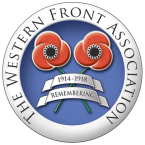32nd Training Depot Station (Montrose), Royal Air Force
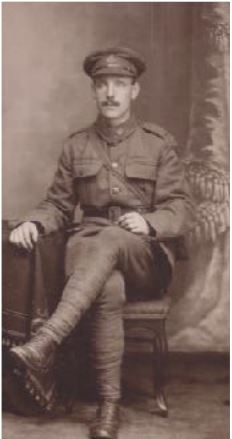
For many people at the turn of the century, life had little to offer other than the routine of leaving school at fourteen, a lifetimes work at the local factory, pit or mill and then retiring into obscurity, probably without a pension and hopefully supported by one’s children. A few, however, had the means and ambition to escape to a more fulfilling life. William Henderson was one such man, leaving England for Canada as soon as he had acquired marketable skills and then, when war broke out, enlisting in the Canadian Expeditionary Force to ‘do his bit’ for King and Country. At the age of 28, still full of ambition and seeing the future lay in aviation, he trained for the highly exciting, if hazardous, life of a pilot in the newly formed Royal Air Force.
William Douglas Henderson was born on 8 December 1889, the son of a draper, Alexander Cameron Henderson, and his wife, Mary. When William was very young the family lived at Clarence Street in Gloucester although they later moved to Sunnybank, a large house in Hucclecote, today the Royal Oak public house. He had eight brothers and sisters and his parents probably needed all the assistance they could get from their two servants and the young governess they employed. In 1896, when William was seven, his father died and his mother was left to care for her large family. With the schooling of her four sons and five daughters to pay for, Mary no doubt welcomed the free education available to choristers when William was accepted into the cathedral choir three years later. He was at school with brothers Will and Eric Harvey (qv) and Harold Organ (qv). His elder brother, Robert, joined him at King’s in 1899 although the oldest boy, Alexander, attended Crypt School.
After leaving school William trained as an auto-mechanic, probably taking an apprenticeship. Not content with a future repairing motor vehicles in a dingy garage he wanted more out of life and, in common with many young men at that time, he saw his future abroad. On 17 May 1911 his younger sister, Margaret, sailed with him from Avonmouth Docks on the steamship Royal George, bound for Canada. The Canadian Northern Line operated the ship at that time although it was later used as a troopship and was the one on which John Vick homas (qv) later died whilst returning from India. Although they travelled together they went their separate ways once they reached Canada. Margaret disembarked at Quebec and later moved on to Ontario, whilst William left the ship at Montreal and secured employment in the timber trade in Athabasca, Alberta. No doubt his skills as an auto-mechanic were in demand in the increasingly mechanized Canadian lumber business. The wide open spaces of the Canadian Rockies must have seemed a far cry from the hedgerows of Gloucestershire. His brother, Alexander, also decided his future lay abroad and he joined the South African Police before also moving to Canada to get married and become a storekeeper in Vancouver.
At the outbreak of war many British men in Canada saw it as their duty to enlist, either returning to the United Kingdom to do so, or joining the Canadian Expeditionary Force. Alexander opted for the latter and joined the Canadian Army in September 1915, going on to serve with the 67th Pioneer Battalion in France. By this time William was living at Sheldrake Avenue, Boulevard, near Toronto and he attested there six months later, naming his sister, now in Ottowa, as his next of kin. He again drew on his skills as an auto-mechanic and joined the 4th Division Ammunition Sub-Park, Canadian Army Service Corps (CASC), a motor transport unit. On 19 May 1916, Private 1261244 Henderson sailed for England with his unit on the SS Adriatic, arriving there on 30 May, and was posted to the CASC Training Depot at Pond Hill Camp, Shorncliffe in Kent. On 20 July his training completed, and after embarkation leave, he sailed to France and arrived at Rouen on 10 August.
Initially, William’s unit was stationed at Houdain, a town not far from Bethune, and they were engaged transporting all manner of munitions, equipment and road building materials for the engineers. On occasion, they would move troops up to the front or return with lorry loads of wounded for the Casualty Clearing Stations and hospitals behind the lines. On at least one occasion their lorries were filled with prisoners captured in trench raids being sent back for interrogation. As autumn arrived they had to contend with colder and wetter weather that hampered movement and made the vehicles difficult to start. They had harsh lessons to learn and one man was killed when he tried to crank the engine with the lorry still in gear. It was hard work getting up the muddy tracks and there were many accidents when the tyres lost grip in the mud and slid back into the following vehicles. Poor grade petrol frayed the fuel lines and a shortage of spares necessitated improvised repairs to their Daimler and Albion lorries.
In March 1917 the unit moved a short distance to a new vehicle park at Hersin. Here they constructed hardstandings to stop the lorries sinking into the sodden ground and were engaged in moving ammunition from the arriving trains to the divisional dumps. They moved trench building materials to Vimy Ridge, where the Canadians were well established, and often encountered shelling on their journeys up and down the line. It was not all hard work and their position behind the front lines gave them the opportunity to play football and baseball, as well as visit the local estaminets and attend concerts and other entertainments arranged for them. The transport units were regularly inspected and competitions were held for the best maintained
vehicles. William’s unit appears to have been particularly efficient and was awarded prizes for maintenance and driving skill.
A move to the Ypres Salient in October 1917 saw an increase in casualties caused by shelling as the lorries operated much closer to the front lines, usually transporting stone for repairing the roads around the town. There were occasional air raids too, although William’s unit escaped these unscathed. At the beginning of December 1917, after sixteen months of overseas service, William was granted fourteen days leave. Paris and England were favourite destinations and it has to be wondered if he took the opportunity to return home to see his family. During this period a number of men left the unit and gained commissions, many of them in the Royal Flying Corps (RFC). Indeed, so many joined the RFC that the adjutant complained in the unit War Diary that he was losing too many good men. William would undoubtedly have known many of them and perhaps it was their accounts of flying training, or meeting up with them during his leave that prompted him to apply. Whatever his reasons, he eventually submitted his application to become a pilot and was accepted into the newly formed Royal Air Force (RAF) in April 1918 at the comparatively late age of 28. On leaving the Army he was awarded his Good Conduct badge and he sailed for England to complete his initial training with No 2 Cadet Wing at Hastings. He was appointed a Flight Cadet (a pilot in training) in July and was posted to the 32nd Training Depot Station (TDS) at Montrose in Scotland for flying training.
The art of air warfare was both new and challenging. The first thing a pilot had to do was learn how to fly and this in itself was an incredibly hazardous process. The frighteningly high casualty rate caused the authorities considerable concern and the matter became so serious that it was raised in the House of Commons. In all, there were over 14,000 deaths amongst pilots, no less than 8,000 of these occurring during training. In other words, more pilots died at home than were killed by the enemy. This averaged out at an amazing six or seven a day, albeit that some of these will have resulted from causes other than flying such as the 1918 influenza epidemic. Whatever the dangers, William accepted them and was an enthusiastic trainee.
Montrose Air Station was established in 1913 and was the country’s first operational Royal Flying Corps airfield. Today it houses a museum and various aviation collections, and is famous for its spooky occurrences, the most famous of which is perhaps the ghost of Lieutenant Desmond Arthur who died in an air crash there in 1913. It trained pilots until the late 1940s and hosted a number of units, both training and operational, including the 32nd Training Depot Station, which was formed in July 1918 through the amalgamation of two former training Squadrons. When William went to Montrose in 1918, the 32nd TDS operated a variety of aircraft types, from the BE2 and Avro 504A trainers to the Sopwith Pup, and the aircraft that for most of the war was the mainstay of the front line fighter squadrons, the Sopwith Camel. Initially, of course, William flew with an instructor in the two-seater training aircraft, probably the BE2, but it was not long before he went solo and moved on to fly the types he would be using operationally, including the famous Camel.
The Camel was an unforgiving aircraft. Inherently unstable, flying it required a great deal of skill and the pilot couldn’t afford to lose concentration for a second. It was said of the Camel that it offered a choice between ‘a wooden cross, a red cross, and a Victoria Cross.’ It was, however, highly manoeuvrable and its agility in combat and ability to loop quickly helped it to gain aerial superiority on the Western Front. About 5,500 were produced and they were equipped operationally with two Vickers .303 machine guns. By the time William progressed to flying this aircraft, the war was drawing to a close and he and his fellow students must have wondered what was to become of them. Some may still have seen their future with the Royal Air Force although many must have recognized that the fast-developing world of air-travel would open up exciting new opportunities when the war was over. Whatever his ambitions, William was going to make the most of his time in the RAF and he continued to hone his skills in advanced training that included aerobatics.
On 28 November 1918 William took one of the training school’s Camels, an F1 serial number F4207, for a practice flight. The aircraft was one of a batch of 40 that were built from salvaged parts at No 3 Aircraft Repair Depot in Yate. Unlike the front line units where pilots often had their own aircraft, the ones at the Training Depot Stations were shared by everyone and were in constant use. In addition, the importance of stringent aircraft maintenance was only just being realized and there were few of the checks and procedures that are routine today. William took off from the Montrose airstrip and started practicing aerobatics above the ancient hill fort at Ironshill, Inverkeilor, putting the Camel through its paces. Even the old First World War biplanes created considerable g-forces on the pilot as they were thrown about the sky and this put quite a strain on the aircraft. As he performed one of the acrobatic manoeuvres, William’s lap strap gave way and he was thrown out of the cockpit. At that time there were no parachutes that a pilot could wear whilst flying and he fell to his death.
The official cause of his death was recorded as a fracture to the base of the skull. The RAF’s subsequent investigation concluded that William was not to blame for the accident, the belt having broken under the strain of the aerobatics. He was over six-foot tall and his size, combined with the heavy winter flying clothing he would have worn, may have contributed to the failure of the strap. His body was returned to Gloucester for burial and the funeral took place at Gloucester Cemetery a few days later. William’s brother-in-law, the Reverend Mackay, took the service, to which the officers of Montrose Air Station sent a wreath composed of flowers representing the colours of the unit. Although two of his fellow officers from Montrose travelled down to Gloucester for the funeral, they arrived too late to attend. As William’s mother had died a few years earlier, the family was represented by two of his sisters and a number of other relatives. William’s equally adventurous brother, Alexander, had already been killed in an artillery barrage in France in May 1917, serving with the 67th Pioneer Battalion of the Canadian Expeditionary Force.
William was buried at Gloucester Cemetery and his grave is marked with a Commonwealth War Graves Commission headstone that bears the family inscription, Let light perpetual shine upon him, O Lord.
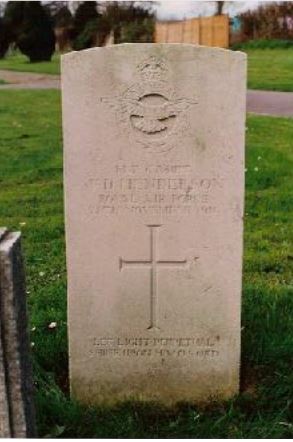
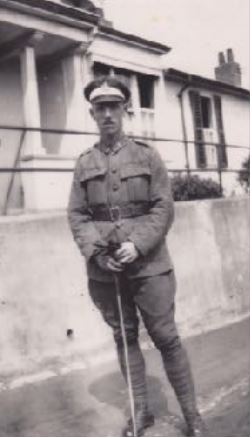
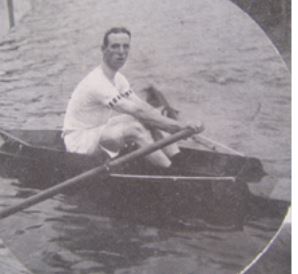
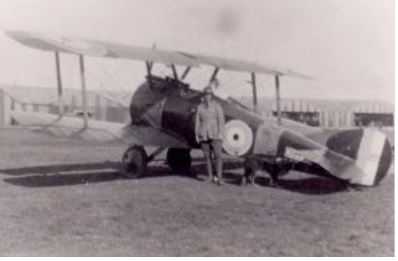
Researched by Bob Brunsdon December 2012
Footnote: According to ‘They played for Gloucester and fought for their Country’ by Martin (with Teresa Davies), Henderson was a rugby union footballer, who originally played for the Gloucester Old Boys Club. He went on to make 16 appearances for Gloucester (Rugby) Football Club in the 1909-10 season.
